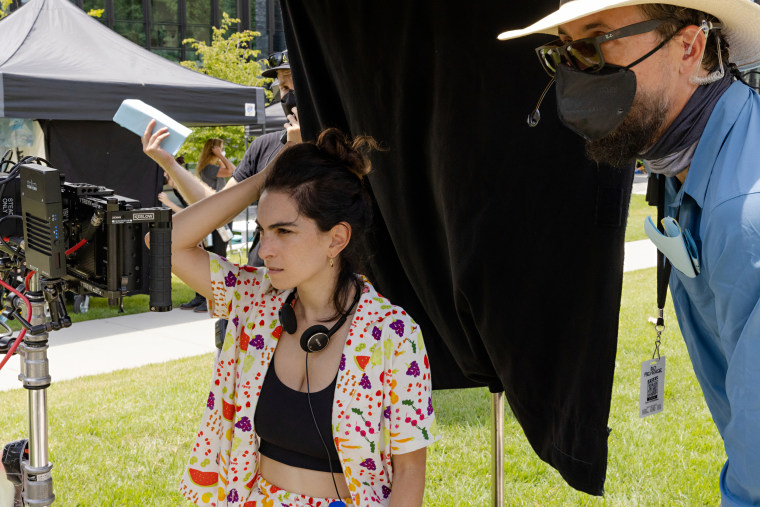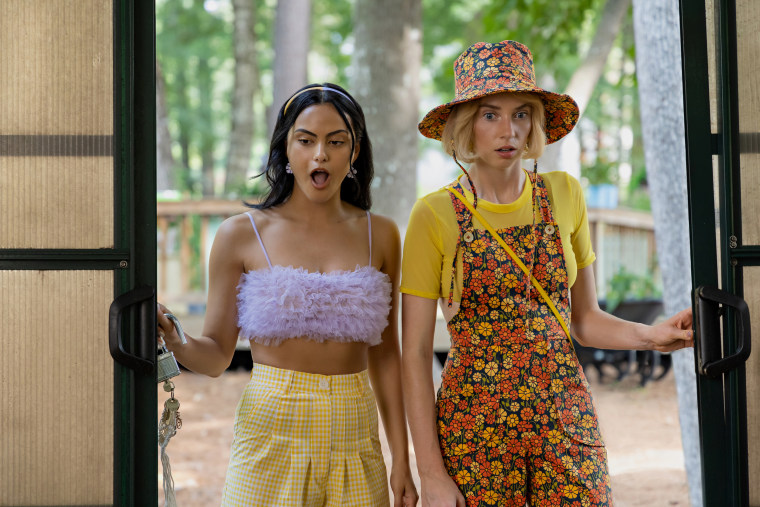“Do Revenge,” Netflix’s new high school revenge-swap dramedy starring Maya Hawke and Camila Mendes, is a minefield of ‘90s teen movie references — from cliques with coordinating outfits to makeover schemes and house parties where popularity is made and lost. And, like its inspirations, which include quintessential films like “10 Things I Hate About You” and “Cruel Intentions,” it even has roots in a work of literature: Patricia Highsmith’s “Strangers on a Train.”
The film, loosely based on the Hitchcock-adapted novel about murder swapping, centers on two attendees of a wealthy, private school populated by some of Gen Z’s brightest stars. The mismatched protagonists — the brooding new girl, Eleanor (Hawke), and the disgraced queen bee, Drea (Mendes) — bond during a clandestine meeting the summer before their senior year and form a pact to enact each other’s revenge. Though, rather than murder, they’re plan is to expose Drea’s fake-woke, golden-boy ex and get payback for Eleanor’s traumatic coming out.
“Patricia Highsmith is high camp, so it felt very intuitive to take [the novel] and put it in this high-gloss, camp environment for teens,” the film’s writer and director, Jennifer Kaytin Robinson, told NBC News. “It was really about staying true to the deliciousness of ‘Strangers on a Train,’ within this world that feels really candy-coated, saturated and fun.”
In addition to “Strangers on a Train,” Highsmith is perhaps best known for writing “The Talented Mr. Ripley” and “The Price of Salt,” the latter of which was adapted into the 2015 lesbian romance “Carol.”
“We said we were creating ‘girl world,’” she added, referring to herself and the film’s costume and production designers. “There’s just something so fun about putting Patricia Highsmith in ‘girl world.’”
To create that world, Robinson, whose film credits include “Thor: Love and Thunder” and “Someone Great,” borrowed from highly stylized classics like “Clueless,” “Heathers” and “Jawbreakers.” Costume-wise, the “Do Revenge” cast of gorgeous 20-somethings are typically either dressed in bubble gum-colored school uniforms or form-fitting wear in a variety of bright hues and see-through fabrics. And even the soundtrack of pop songs and camera work, which includes montages of school cliques and aerial shots, pay homage to the ‘90s teen genre — as do its central storylines.
Like many ‘90s leads, Drea’s reign over the school’s popular kids — who one character describes as being “as calculated as they are beautiful,” riffing on a line from 1999’s “Cruel Intentions” — comes to an end when she’s publicly humiliated during the film’s opening. A nude video of her is leaked online and the most likely culprit is her boyfriend, Max (Austin Abrams of “Euphoria” fame), who wields significantly more power over the privileged student body than Drea, who attends the school on a scholarship. Following the scarring incident, not even the school’s headmaster, played by none other than Sarah Michelle Geller, is willing to take Drea’s side.
That’s when, friendless and in risk of losing her chance at Yale, she meets a new transfer, Eleanor, who unlike Drea is no stranger to being a social pariah. During their first encounter, which includes an amusing cameo by Sophie Turner (“Game of Thrones”), Eleanor describes how one of their mutual classmates accused her of being a predator when she came out as queer to the girl at camp. Bonded by their respective traumas and dread about the coming school year, the two eventually hatch a plan to “do revenge” for each other and get away with it.
While the ensuing scheme involves plenty of predictable moments, from a makeover that gets Eleanor in with the popular kids to an inconvenient romance between Drea and her target’s best friend, Robinson also builds in some twists and turns befitting of the film’s thriller roots.
“I wanted to make a story where everyone was the hero, and everyone was also the villain,” Robinson said, adding that she wanted to look at how bad choices are inevitable when you’re young and figuring yourself out.
In addition to Robinson’s obvious passion for the project, the morally questionable characters that she and co-writer Celeste Ballard created to explore those themes are what attracted their stars, who are very familiar with what it takes to make a teen hit.

“It’s shockingly rare that you hear from someone that really makes you understand how much it means to them to make this movie. That’s all you really want …. and a vision,” Hawke, who is best known for her role in “Stranger Things,” told NBC News.
As for Mendes, who starred in “Riverdale,” she said, “For me, I was, like, ‘I’ve done teen movies. Why is this one any different?’”
“It’s different in a million ways,” she added. “It’s so fresh and original and also has all these amazing nostalgic references. And, on top of that, the emotional depth of the movie — it’s a really beautiful story about healing your trauma.”
For Mendes’ Drea, that trauma is being betrayed by the people she thought she could trust, who care more about her relatively limited means than she realized. Meanwhile, Hawke’s Eleanor is haunted by the idea of being seen as a victimizer, which is Robinson’s contemporary spin on the queer adolescent storyline and on the subtext running through her source materials.
“Of course, there are queer undertones in a lot of the ‘90s and 2000s movies that I really love, and there are obviously queer undertones in Patricia Highsmith’s writing, but, for me, it was about telling a story that felt true to being young today. So there was never a version of this film where Eleanor wasn’t a queer character,” Robinson said.
“In talking to a lot of young people today, their relationships to queerness is so different and evolved,” she added. “So I didn’t want the story of Eleanor to be about her being outed; it’s what happened when she was outed.”
The choice to move beyond a coming-out story appealed to Hawke, whose “Stranger Things” character, Robin, is also queer.
“From the first moment, Eleanor is pretty comfortable with her sexuality and is therefore given license to have a story arc that has nothing to do with her sexuality — which, for women, no matter what your sexual preference is, or the preferences of your character, is rare,” Hawke said. “Usually the stories hinge upon your sexuality in one way or another.”
For Robinson, the sympatico relationship that she had with both her stars, and they with their characters, was essential to the film’s successful outcome. In fact, the director moved the filming location to Atlanta so that both Hawke and Mendes were able to sign on. And, given the chemistry between the two actors, her effort paid off.
“It was crazy how instant it was,” Mendes said, referring to her onset chemistry with Hawke. “I admired her as an actor. I watched ‘Stranger Things,’ so I knew her work, and when I heard she was already attached, it made me want to be part of the project that much more.”
Hawke agreed, saying, “We have great chemistry as people, and I love our chemistry on screen.”
“But, also, part of what makes actors actors is that they are people who are good at having chemistry with people,” she added. “That’s part of what the job is: connecting with people. And sometimes you make a real friend, and sometimes you don’t, but the connection on screen is a part of the job.”
